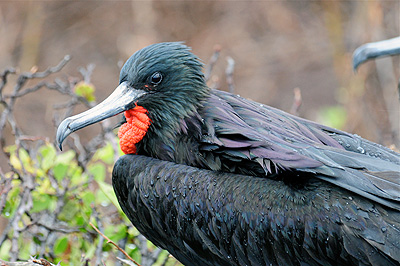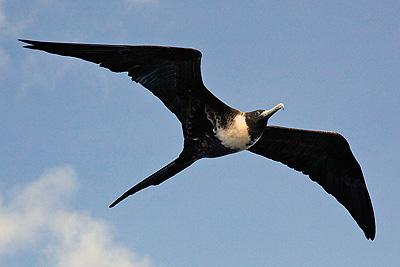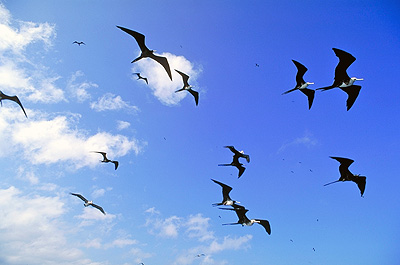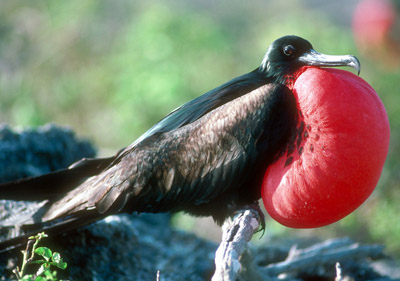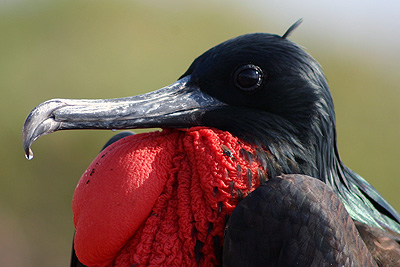There are two species of frigatebirds found on the Galapagos Islands, the Great and Magnificent varieties (it appears neither is troubled by modesty). Both species are large birds, very similar in appearance and are impressive and elegant fliers.
They are both given to kleptoparasitism whereby they steal food and nesting materials from any other species (including their own) where they think they can get away with it. Their Spanish name, "Pajaro pirata" means "pirate bird" and is perhaps more apt.
Great Frigatebird - Fregata minor ridgwayi
Magnificent Frigatebird - Fregrata magnificens
Profile - Animals of the Galapagos
The two Galapagos species of frigatebirds (also called Man 'o War birds) are almost indistinguishable from each other unless seen close up, the Great Frigatebird has a greenish sheen on the feathers on its back, while the Magnificent frigatebird has a purplish sheen.
Galapagos frigatebirds facts - Basics
Weight: Males 1 to 1.45 kg (2.2 - 3.3 lb) at maturity, females are larger 1.215 to 1.59kg (2.7 - 3.5 lb). The Magnificent is a little larger than the Great but there is not much difference and a great deal of overlap.
Length: 89 - 114 cm (35 - 45 in), again the Magnificent is slightly larger with the Great reaching a maximum of around 105 cm.
Wingspan: Great 205 - 230 cm (81 - 91 in) / Magnificent 217 - 244 cm (85 - 96 in).
These are very large, but lightly built birds for their size, they have the lowest wing-loading of any birds, the largest wing area to body weight ratio.
Breeding Season: Males of both species have a large bright red "gular sac" which they are able to fill with air, this is used for display during mating rituals. The larger females do not have this sac and instead have a white normally feathered throat and breast region. Both species nest colonially in bushes and trees, courtship can take from 2 days to a month. In common with many tropical birds, breeding can happen at any time of the year often prompted by plentiful food. Sexual maturity is not reached until about 8-9 years in females and 10-11 years in males.
A single egg when laid is incubated for 42-55 days, the young are dependent on the parents for up to a year after fledging. This can result in a 2-yearly breeding cycle rather than annual and is amongst the longest of any birds.
Feeding: Feed on prey driven to the sea surface by underwater predators such as tuna. Frigatebirds can they soar in the air for many hours with little energetic cost and so can cover huge areas of ocean where prey is scarce. Any fish will be taken, but mainly flying-fish and squid, jellyfish, also opportunistically, baby turtles, seabird eggs and chicks. They exhibit kleptoparasitism (klepto - thief) chasing and harrying other smaller sea birds causing them to drop or regurgitate food that they then eat, though this supplies a relatively small portion of their food. Magnificent frigatebirds fish closer inshore than the Great whose fishing technique is difficult to master leading to the young being dependent on the adults for longer.
Conservation status: Least concern, no specific estimates but numerous, over 100,000. Found in the Americas along Pacific, Cariibean and Atlantic coasts within the tropic belt.
Predators: They have been hunted by humans at various times, though this has largely stopped now (and there's not a lot of food on a lightweight frigatebird). No other predators on the adults, like any birds the eggs young may be vulnerable to native and introduced predators.
What are Frigatebirds Like?
Frigatebirds are one of the world's great fliers, they have been tagged and tracked flying for up to two months without landing , they can cover 400km or more per day. They have distinctive W wing shape in flight with a scissor tail and a long hooked beak, their wingspan is over 2m.
Very unusually for sea birds, they don't have waterproof feathers and so can't and don't rest on the ocean, they feed usually on the wing scooping up fish, squid and other foods near to the surface. Unsurprisingly their version of flying doesn't involve much flapping flight and is energetically very efficient. Flight for frigatebirds consists mainly of wing adjustments and soaring. They gain height by flying into thermals or upwards moving air currents, rising to 600m or so before slowly losing height again while surveying the surface of the ocean for potential food. In this manner they stay aloft feeding and even sleeping day after day without needing to land to rest.
They sometimes even enter the turbulent atmosphere of cumulus clouds rising inside the cloud and gaining up to 4,000m in altitude, experiencing very frigid temperatures all the more surprising for a tropical bird.
Frigatebird flight tracking - Video
Great Frigatebird Mating Display - Video
Top banner female Great Frigatebird - Dick Daniels carolinabirds.org used under CC3 Attribution Share alike Unported license.

